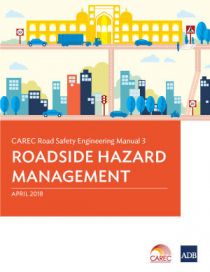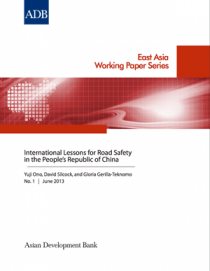Development of Road Safety Policy and Action Plan: Technical Assistance Consultant’s Report
The overall aim of the project is to support the Government of Mongolia in its endeavor of improving its road safety management capacity in order to reduce accident levels and related fatalities.
Consultants' reports describe activities by a consultant or group of consultants related to preparing a technical assistance project.
This document dated September 2018 is provided for the ADB project 49139-001 in Mongolia.
Road Safety Annual Report 2015: Chapter 6 - Cambodia
The International Traffic Safety Data and Analysis Group (IRTAD) is a permanent working group of the Joint Transport Research Centre of the OECD and the International Transport Forum. It is composed of road safety experts and statisticians from renowned safety research institutes, national road and transport administrations, international organisations, universities, automobile associations, the automobile industry, and others from OECD and non-OECD countries. Its main objectives are to contribute to international co-operation on safety data and its analysis. Its key outputs are the IRTAD Database that currently publishes safety data from 32 countries and its annual report on road safety performance. It also conducts regular research and analysis on topics related to safety data analysis (e.g. forecasting, relationship between speed and crash risks, road safety and economic developments).
This chapter presents the most recent crash data for Cambodia, as well as an update on the Cambodian road safety strategy and recently implemented safety measures.
All data stem from National Road Safety Committee unless otherwise noted. The National Road Safety Committee joined the International Road Traffic and Accident Database (IRTAD) group in 2010. Data presented in this report are data reported by police and are under validation by IRTAD. Actual numbers are likely to be higher.
State Program of Azerbaijan Republic on Road Safety for 2019-2023
The State Program of the Azerbaijan Republic on Road Safety for 2019–2023 is multisectoral and designed to be implemented on national, regional, and global levels, with a primary focus on national- and local-level actions. The implementations are designed according to the five pillars of the Decade of Action for Road Safety 2011–2020:
- Road safety management
- Safer roads and mobility
- Safer vehicles
- Safer road users
- Post-crash response
Road Safety Policy and Implementation in Mongolia
Road Safety in Cambodia
Road Safety for Road Users in Cambodia
Road Safety Awareness - Pathway to Saving Lives in Azerbaijan
Country Statement: Islamic Republic of Afghanistan
CAREC Road Safety Engineering Manual 3: Roadside Hazard Management

Single vehicle “run-off road” crashes are a significant problem on CAREC roads. They are particularly severe and can occur anywhere and at any time. Identifying, investigating, and treating roadside hazards are significant road safety challenges along CAREC highways. It uses a roadside hazard management strategy and the clear zone concept to explain how CAREC road authorities can (i) identify roadside hazards, (ii) investigate how best to treat those roadside hazards, and (iii) implement effective safety improvements. The manual explains the three groups of safety barriers and offers options for safer roadside furniture.
About the CAREC Road Safety Engineering Manuals
The series of road safety engineering manuals of the CAREC Program came from the endorsement of the 2017-2030 CAREC Road Safety Strategy 2017-2030 by member countries. The strategy supports and encourages CAREC authorities to plan, design, construct, and maintain safe roads.
International Lessons for Road Safety in the People's Republic of China

Road traffic collisions are a serious constraint to development and a burden to many low- and middle-income countries. The World Health Organization estimates that each year around 1.2 million deaths and between 20 and 50 million injuries occur on the world's roads. These road traffic collisions are a serious constraint to development and a burden to many low and middle income countries.
Acknowledging the global importance of road safety as a development issue, this staff working paper considers approaches and good practices for road safety which have been adopted in the best performing countries during recent decades, drawing in part on the findings of a technical assistance project on Improving Road Safety through the Application of Intelligent Transport Systems in the People's Republic of China (PRC), it suggests how these can be useful for reducing road traffic deaths and injuries in the PRC.
Conclusions
Road traffic collisions are a major global health problem, leading to similar numbers of worldwide deaths as malaria or tuberculosis. The great majority of these deaths occur in low and medium income countries, where the problem is often getting worse due to increasing motorization. In contrast, many high income countries, despite their high levels of vehicle ownership, demonstrate steady improvement.
This paper has identified lessons from high income countries that have been successful in road safety that are relevant for the PRC and other low and medium income countries to draw upon and benchmark, in their efforts to reduce road traffic deaths and injuries. These include the following:
- Because road safety is a multi-sectoral, multi-disciplinary issue, coordination of actions by all relevant agencies is critical. The most successful countries have a strong multi-stakeholder coordination mechanism, with a lead agency to oversee and ensure coordinated actions;
- An action plan, with quantified targets against which progress can be assessed and outcomes evaluated, helps to give focus and momentum to the implementation of road safety policies. Evaluation of the impact of projects and policies is important to inform future actions and for updating of the action plan; and
- Actions are needed at national and local government levels. Professional staff, with responsibilities for road safety, need to be trained and recruited for all levels of government.
Pagination
- Previous page
- Page 10
- Next page